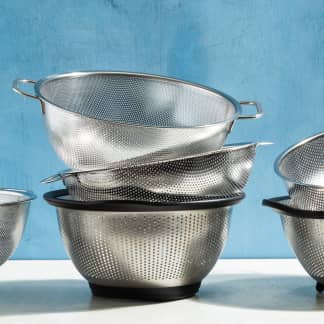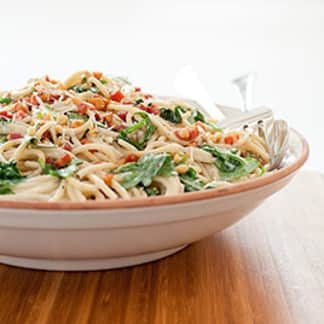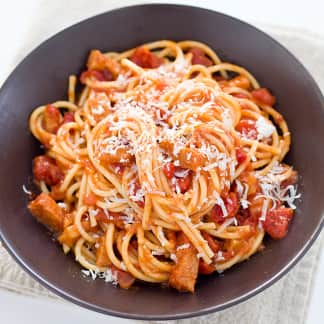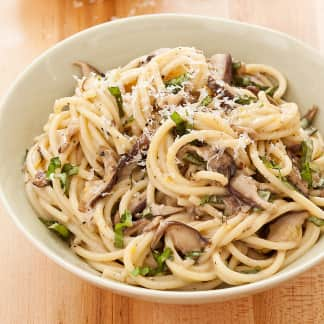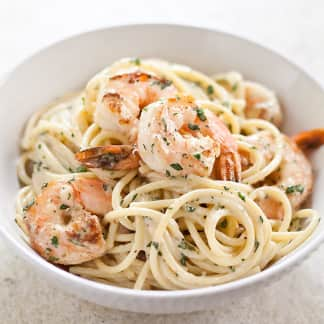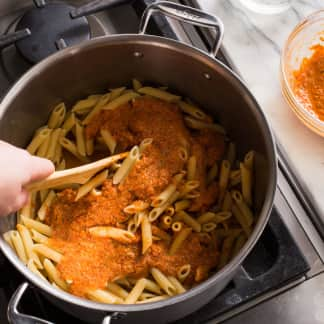Reviews You Can Trust.
See Why.
Spaghetti
Our tests proved that once pasta is topped with sauce, flavor differences from brand to brand are very subtle. But texture is a whole different story.
Top Pick

WinnerDe Cecco Spaghetti No. 12
This Italian import boasted “clean wheat flavor” and a “firm, ropy quality”; in fact, the lab confirmed these strands as the strongest of all the samples, with the lowest percentage of “cook loss.” The texture was just as good when we added sauce—“firm,” with “good chew.”
Source: Italy
Ingredients: Durum wheat semolina, niacin, ferrous lactate, thiamine mononitrate, riboflavin, folic acid
Processing Method: Pressed through bronze dies; dried at 158°
Starch in cooking water: 4.88%
Price at Time of Testing: $1.39 for 1 lb
This Italian import boasted “clean wheat flavor” and a “firm, ropy quality”; in fact, the lab confirmed these strands as the strongest of all the samples, with the lowest percentage of “cook loss.” The texture was just as good when we added sauce—“firm,” with “good chew.”
Source: Italy
Ingredients: Durum wheat semolina, niacin, ferrous lactate, thiamine mononitrate, riboflavin, folic acid
Processing Method: Pressed through bronze dies; dried at 158°
Starch in cooking water: 4.88%
Price at Time of Testing: $1.39 for 1 lb
Sign up for the Well-Equipped Cook newsletter
Shop smarter with our ATK Reviews team's expert guides and recommendations.
What You Need to Know
Given its impressive sales figures, you’d never guess that spaghetti (and all dried semolina pasta) was once an obscure ingredient made almost exclusively in Italy. Last year Americans spent $1.5 billion on these strands, using them as a quick base for everything from hearty ragu, to grassy pesto, to plain old butter and cheese. Besides convenience, the other draw of dried spaghetti is that it’s inexpensive—or at least it used to be. When we recently browsed the options at the supermarket, we discovered that while you can still pick up a 1-pound package for as little as a dollar and change, you can also spend more than three times that amount. For a product that typically lists just durum semolina (coarsely ground durum wheat, the universal choice for dried pasta) and maybe added vitamins, the difference in price is astonishing. How much better could a pound of pasta costing more than $4 really be?
To answer that question, we rounded up eight nationally available brands ranging in price from $1.39 to $4.17 per pound. Two were domestically made bestsellers, and the remaining six were Italian imports. (New World Pasta, the producer of one of the domestic samples, is a conglomerate that also bought out several other regional American brands, and it uses the same formula to make them all.) We cooked the strands until al dente and tasted them two ways: glossed with mild-flavored olive oil and coated with a simple tomato sauce. We knew what we were looking for: Good pasta tastes clean, wheaty, and faintly nutty and boasts a firm, springy chew, with nary a hint of starchiness or gumminess.
The Spaghetti Breakdown
We’ll level with you. When it came to taste, there wasn’t a truly bad noodle in the bunch. With a few exceptions, the oil-dressed samples tasted pretty darn similar, garnering at least a few compliments like “buttery,’’ “nutty,” or “toasty.” Flavor differences were even harder to tease out once the tomato sauce came into play, and all of the spaghettis grasped the marinara relatively well.
Texture, however, was another matter. We cooked the spaghetti according to the times suggested on their packages (8 to 13 minutes, depending on the strands’ thickness) and removed them from the boiling water early if they tasted “done.’’ None of the samples were unacceptable, but regardless of how vigilantly we tracked their doneness, some noodles cooked up sticky and gummy, while the best spaghettis were springy and firm.
Just to weed out any possibility of operator error, we sent a package of each spaghetti to an independent lab, Northern Crops Institute, at North Dakota State University. The lab cooked and then evaluated the samples based on three criteria: the finished weight of the cooked noodles (a measure of how much water the noodles absorb during cooking), “cook loss’’ (how much dissolved starch the noodles release into the cooking water), and firmness (how much force it takes to cut through a strand of cooked pasta). The lab’s findings confirmed our own: Our favorite spaghetti had a relatively low cooked weight, the least starchy water by a large margin, and the firmest texture after boiling. Now we just needed to figure out why.
Since the ingredient lists don’t vary much, we were skeptical that we’d find many answers on the package labels, but we gave them closer scrutiny anyway. No surprise: Semolina was the primary ingredient in every sample. Besides being distinguished by its tawny golden color, this coarsely milled durum wheat is high in protein, which ensures a particularly strong gluten network that helps the noodles maintain their springy, resilient texture as they boil.
The more significant discovery was that both of the American-made spaghettis also contain durum flour. According to Mehmet Tulbek, technical director at Northern Crops Institute, durum flour contains the same high level of protein as semolina, but it’s a finer, cheaper grind that some manufacturers blend into the dough to help contain costs. The trade-off, according to Tulbek, is that the finer particles of durum flour tend to break down more easily, so the noodles leach more starch and turn mushy more easily. Cutting corners with durum flour might account for why some tasters found the texture of these two brands “gummy” and “mealy,” particularly when sampled with nothing more than olive oil to cover their flaws.
But that still didn’t explain the mushy texture we detected in some of the pastas made with 100 percent semolina. Could the way the dough was processed also affect the texture?
Pressing Matters
To cut pasta into shapes, most dough is passed through the holes of a die. All dies were originally made with bronze blocks, which give the noodles’ surface a rough-hewn, almost dusty appearance that some manufacturers still prefer; they claim that sauce clings better to the coarse, craggy exterior. Meanwhile, other pasta producers, including both American brands in our lineup, have switched to Teflon-coated dies, mostly for cosmetic reasons. Because it’s nonstick, Teflon reduces the surface tension of the dough extrusion and, as a result, produces smoother, shinier noodles. We found that sauce clung equally well to noodles made by both types of dies—but could bronze dies be responsible for producing the firmer texture we noticed in some of the spaghettis? As it turned out, no. While our favorite pasta was produced by bronze dies, so were our two least favorite brands, assailed for having “mushy,” “soft” texture “with no spring in the bite.”
According to Tulbek, the more important distinction is not the material of the die; it’s a question of how well the extruder and the die have been maintained. Whether bronze or Teflon, dies don’t last forever; the heat, friction, and pressure applied to the dough wear down and loosen the extruder parts over time. When this happens, the machine is no longer able to press the dough with enough force to make perfectly compact strands of spaghetti, and the texture of the noodles suffers. Based on our results, we could only assume that some extruders were in better shape than others.
Degrees of Difference
The other major processing step is drying the noodles. Drying times and temperatures range widely among brands: Some companies dry their pasta low (95 to 100 degrees) and slow (over many hours, or even days) in drying rooms, claiming that it preserves flavor. Others, including Barilla and Ronzoni, place the noodles in special ultra-high-temperature (UHT) ovens and crank the heat to 190 degrees or higher, which gets the job done faster. According to Tulbek, the high heat cross-links some of the gluten strands and can strengthen the pasta. But UHT drying has a downside: It tends to cook out some of the pasta’s flavor, an effect we noticed in the duller taste of these two UHT-dried brands.
Ultimately, we liked six of the eight samples enough to recommend them. But one pasta, stood out for particularly good texture—the result, we could only assume, of balancing all the variables most successfully. It contains no durum flour, is likely extruded through well-maintained dies, and dries for 18 hours at a moderately high 158 degrees. That combination of factors made for rich, nutty, wheaty-tasting strands that retained their al dente bite better than other brands—including the priciest samples. In fact, at $1.39 a pound, it was one of the two least expensive spaghettis we tasted. The priciest sample in the lineup came in at a close second. But we won’t ever feel a need to reach for it as long as there’s a cheaper box of better quality on the shelf.
America's Test KitchenWatch Now
Everything We Tested
Recommended

WinnerDe Cecco Spaghetti No. 12
This Italian import boasted “clean wheat flavor” and a “firm, ropy quality”; in fact, the lab confirmed these strands as the strongest of all the samples, with the lowest percentage of “cook loss.” The texture was just as good when we added sauce—“firm,” with “good chew.”
Source: Italy
Ingredients: Durum wheat semolina, niacin, ferrous lactate, thiamine mononitrate, riboflavin, folic acid
Processing Method: Pressed through bronze dies; dried at 158°
Starch in cooking water: 4.88%
Price at Time of Testing: $1.39 for 1 lb
This Italian import boasted “clean wheat flavor” and a “firm, ropy quality”; in fact, the lab confirmed these strands as the strongest of all the samples, with the lowest percentage of “cook loss.” The texture was just as good when we added sauce—“firm,” with “good chew.”
Source: Italy
Ingredients: Durum wheat semolina, niacin, ferrous lactate, thiamine mononitrate, riboflavin, folic acid
Processing Method: Pressed through bronze dies; dried at 158°
Starch in cooking water: 4.88%
Price at Time of Testing: $1.39 for 1 lb
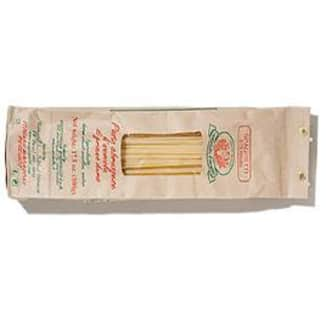
Rustichella D’Abruzzo Pasta Abruzzese di Semola di Grano Duro
Even though these noodles were dried at a low 95 degrees (higher drying temperatures can produce stronger strands), they retained a delightfully “firm” bite and chew that tasters raved about. We also appreciated this pricey Italian brand’s “nutty,” “toasty” taste, which came through even under a coating of marinara.
Source: Italy
Ingredients: Durum wheat semolina
Processing method: Pressed through bronze dies; dried at 95°
Starch in cooking water: 5.78%
Price at Time of Testing: $4.56 for 17.5 oz ($4.17 for 1 lb)
Even though these noodles were dried at a low 95 degrees (higher drying temperatures can produce stronger strands), they retained a delightfully “firm” bite and chew that tasters raved about. We also appreciated this pricey Italian brand’s “nutty,” “toasty” taste, which came through even under a coating of marinara.
Source: Italy
Ingredients: Durum wheat semolina
Processing method: Pressed through bronze dies; dried at 95°
Starch in cooking water: 5.78%
Price at Time of Testing: $4.56 for 17.5 oz ($4.17 for 1 lb)

Garofalo Spaghetti
Tossed with olive oil, this Italian pasta ranked highest for flavor that was “buttery” and “rich-tasting” and had a “roughness” to the exterior that numerous tasters appreciated. However, that pleasant coarseness was obscured by the sauce, under which the noodles became slightly “gummy.”
Source: Italy
Ingredients: Durum wheat semolina, niacin, iron lactate, thiamine mononitrate, riboflavin, folic acid
Processing Method: Pressed through bronze dies; dried at 176°
Starch in cooking water: 5.42%
Price at Time of Testing: $2.49 for 1 lb
Tossed with olive oil, this Italian pasta ranked highest for flavor that was “buttery” and “rich-tasting” and had a “roughness” to the exterior that numerous tasters appreciated. However, that pleasant coarseness was obscured by the sauce, under which the noodles became slightly “gummy.”
Source: Italy
Ingredients: Durum wheat semolina, niacin, iron lactate, thiamine mononitrate, riboflavin, folic acid
Processing Method: Pressed through bronze dies; dried at 176°
Starch in cooking water: 5.42%
Price at Time of Testing: $2.49 for 1 lb

DeLallo Spaghetti No. 4
In general, tasters found this spaghetti to be “middle-of-the-road.” It didn’t stand out for having major flaws, and it didn’t elicit rave compliments. Its taste was “light” but still “wheaty,” while its texture was deemed “fine,” with “nice elasticity” and “fair chew.”
Source: Italy
Ingredients: Semolina, ferrous lactate (iron), niacin, thiamine mononitrate, riboflavin, folic acid
Processing Method: Pressed through bronze dies; dried at 167°
Starch in cooking water: 6.32%
Price at Time of Testing: $2.81 for 1 lb
In general, tasters found this spaghetti to be “middle-of-the-road.” It didn’t stand out for having major flaws, and it didn’t elicit rave compliments. Its taste was “light” but still “wheaty,” while its texture was deemed “fine,” with “nice elasticity” and “fair chew.”
Source: Italy
Ingredients: Semolina, ferrous lactate (iron), niacin, thiamine mononitrate, riboflavin, folic acid
Processing Method: Pressed through bronze dies; dried at 167°
Starch in cooking water: 6.32%
Price at Time of Testing: $2.81 for 1 lb

Ronzoni Spaghetti
Overall, this brand passed muster. But perhaps due in part to ultra-high-temperature drying, which cooks out flavor, some tasters thought this mass-market American spaghetti “lacked nuttiness.” The inclusion of fine-ground durum flour may have accounted for why some tasters found the texture “mealy.”
Source: USA
Ingredients: Semolina (wheat), durum flour, niacin, iron (ferrous sulfate), thiamine mononitrate, riboflavin, folic acid
Processing Method: Pressed through Teflon-coated dies; dried at 190°
Starch in cooking water: 5.68%
Price at Time of Testing: $1.39 for 1 lb
Overall, this brand passed muster. But perhaps due in part to ultra-high-temperature drying, which cooks out flavor, some tasters thought this mass-market American spaghetti “lacked nuttiness.” The inclusion of fine-ground durum flour may have accounted for why some tasters found the texture “mealy.”
Source: USA
Ingredients: Semolina (wheat), durum flour, niacin, iron (ferrous sulfate), thiamine mononitrate, riboflavin, folic acid
Processing Method: Pressed through Teflon-coated dies; dried at 190°
Starch in cooking water: 5.68%
Price at Time of Testing: $1.39 for 1 lb

Barilla Spaghetti
"There is something a little flat about the flavor of this," said one taster about this American bestseller, which we speculated must have been dried at a temperature high enough to make it taste less wheaty than some. Others agreed, some also noting the noodles’ “gummy” consistency. Overall, though, tasters found the strands “OK” but “unremarkable.”
Source: USA
Ingredients: Semolina (wheat), durum flour, niacin, iron (ferrous sulfate), thiamine mononitrate, riboflavin, folic acid
Processing Method: Pressed through Teflon-coated dies; dried at ultra-high temperature (company would not provide exact data)
Starch in cooking water: 5.62%
Price at Time of Testing: $1.67 for 1 lb
"There is something a little flat about the flavor of this," said one taster about this American bestseller, which we speculated must have been dried at a temperature high enough to make it taste less wheaty than some. Others agreed, some also noting the noodles’ “gummy” consistency. Overall, though, tasters found the strands “OK” but “unremarkable.”
Source: USA
Ingredients: Semolina (wheat), durum flour, niacin, iron (ferrous sulfate), thiamine mononitrate, riboflavin, folic acid
Processing Method: Pressed through Teflon-coated dies; dried at ultra-high temperature (company would not provide exact data)
Starch in cooking water: 5.62%
Price at Time of Testing: $1.67 for 1 lb
Recommended with reservations

Montebello Organic Spaghetti
It wasn’t flavor criticisms that sank this imported spaghetti to the lower rungs of the chart; most tasters praised the “clean,” “bright,” “almost nutty” taste. These strands lost the most starch during cooking, for a “mushy,” “crumbly” texture.
Source: Italy
Ingredients: Organic durum wheat semolina
Processing Method: Pressed through bronze dies; dried at 130–150°
Starch in cooking water: 7.56%
Price at Time of Testing: $2.99 for 1 lb
It wasn’t flavor criticisms that sank this imported spaghetti to the lower rungs of the chart; most tasters praised the “clean,” “bright,” “almost nutty” taste. These strands lost the most starch during cooking, for a “mushy,” “crumbly” texture.
Source: Italy
Ingredients: Organic durum wheat semolina
Processing Method: Pressed through bronze dies; dried at 130–150°
Starch in cooking water: 7.56%
Price at Time of Testing: $2.99 for 1 lb

Bionaturae Organic 100% Durum Semolina Spaghetti
This Italian brand was “sticky” and “soft” and offered “no spring in the bite,” possibly due to a weaker gluten structure resulting from a low drying temperature. But the low temperature didn’t seem to preserve a good wheaty taste; most tasters homed in on one particular adjective: “bland.”
Source: Italy
Ingredients: Organic durum wheat semolina
Processing Method: Pressed through bronze dies; dried at 95–100°
Starch in cooking water: 5.70%
Price at Time of Testing: $3.59 for 1 lb
This Italian brand was “sticky” and “soft” and offered “no spring in the bite,” possibly due to a weaker gluten structure resulting from a low drying temperature. But the low temperature didn’t seem to preserve a good wheaty taste; most tasters homed in on one particular adjective: “bland.”
Source: Italy
Ingredients: Organic durum wheat semolina
Processing Method: Pressed through bronze dies; dried at 95–100°
Starch in cooking water: 5.70%
Price at Time of Testing: $3.59 for 1 lb
*All products reviewed by America’s Test Kitchen are independently chosen, researched, and reviewed by our editors. We buy products for testing at retail locations and do not accept unsolicited samples for testing. We list suggested sources for recommended products as a convenience to our readers but do not endorse specific retailers. When you choose to purchase our editorial recommendations from the links we provide, we may earn an affiliate commission. Prices are subject to change.
Reviews You Can Trust
The mission of America’s Test Kitchen Reviews is to find the best equipment and ingredients for the home cook through rigorous, hands-on testing. Have a question or suggestion? Send us an email at atkreviews@americastestkitchen.com. We appreciate your feedback!
Reviews You Can Trust.
See Why.


